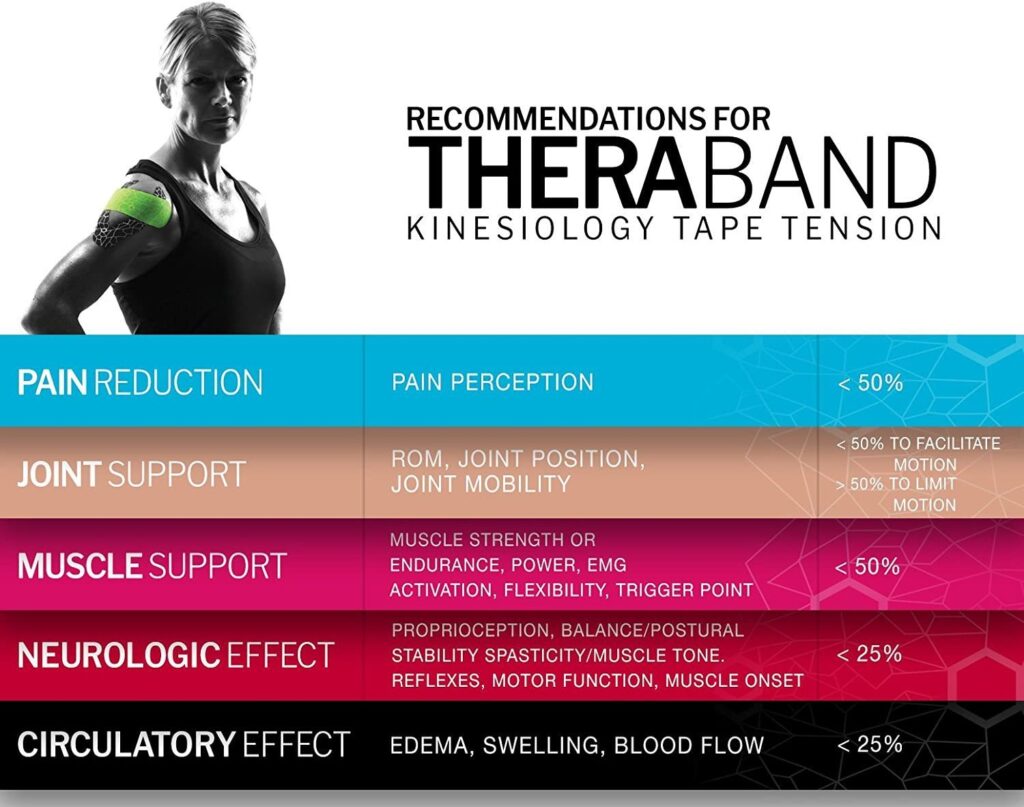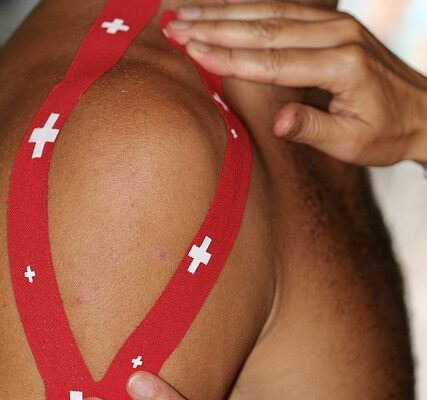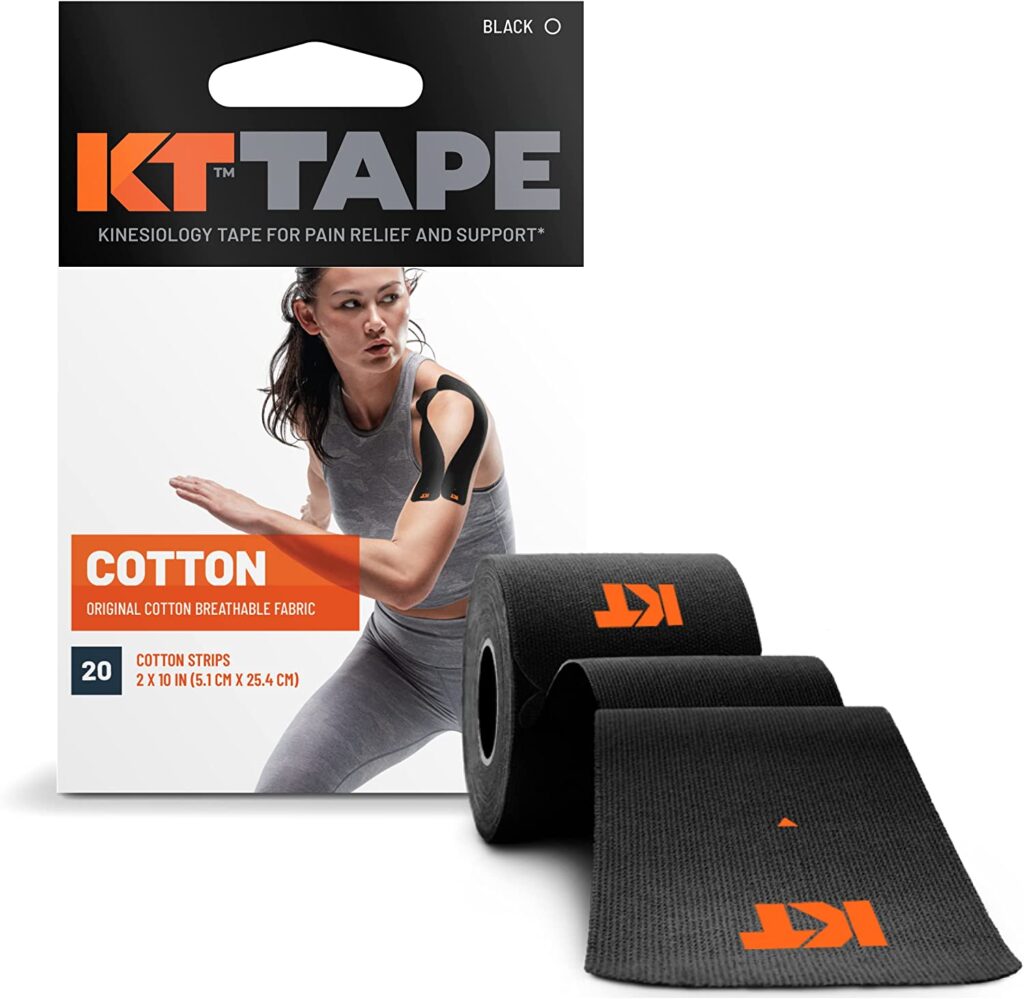Kinesiology tape is a therapeutic, elastic, and breathable tape that can directly target sore areas and injured muscles. It is widely used by athletes and fitness enthusiasts all over the world. Kinesiology, in particular, is the scientific study of the mechanics of body motions.
According to John Honerkamp, Founder, and CEO of RUN KAMP, “It’s a roll of tape with an adhesive that has a healing agent designed to give more support and alleviate pain to an injured part of your body or part(s) that has a higher chance of getting reinjured.”
From hurting shoulders to aching knees, you’ve probably seen athletes in the Olympics and other athletes on TV wrapped up in this, at times, colorful, eye-catching tape. Athletes and celebrities such as Rose Lavelle, Mark Wahlberg, John Cena, and others have been seen wearing the tape as they leave gyms and playing grounds.
The origins of kinesiology tape can be traced back to chiropractor and acupuncturist Kenzo Kase, who developed his taping technique in 1979 to promote blood flow and injury alleviation. The tape is sometimes referred to as “kinesio tape.”
Kinesiology tape has been proven in studies to be effective. According to one 2012 study, this tape improved pain levels significantly and range of motion in patients with acute whiplash-related disorders of the cervical spine immediately and 24 hours after injury.”
Kinesiology Tape Application
Every kinesiology tape provider usually provides detailed directions for applying the tape on their websites, but in general, you’ll apply cut strips of tape to the problematic area before going out to exercise.
There are several ways to apply the tape, and in particular places of the body, such as the calf muscles and shoulder blades, layering the tape or applying it in a specific form can aid. The kinesiology tape is very stretchy, so you can stretch the tape as needed by attaching one end to your skin as you are applying.

The key is to apply it to the areas you feel you are having issues with, like pulled-muscle, so that the tape can put pressure and provide support so you can perform or do your normal workout. The adhesive may also contain a swelling-reducing agent or an agent that aids in the circulation of blood to the area.
In addition, utilize kinesiology tape for any location where you have stiffness and discomfort and want aid supporting or warming up that muscle.
“There is little risk in trying this type of tape,” he adds. “It’s not too expensive, and you can simply remove it if it’s not working properly or is too tight.”
Kinesiology tape companies frequently have how-to videos on their websites, and YouTube is also a good option if you want to tape a specific area.
The Advantages of Using Kinesiology Tape
Athletes frequently sing the kinesiology tape’s praises, citing less pain and inflammation, greater circulation, supportive muscles, and even improved performance during workouts and sports.
Honerkamp believes that it does, in fact, assist injured muscles (and joints), warm up portions of the body, and aid in rehabilitation. Although elite athletes frequently utilize kinesiology tape, anyone who works out or participates in athletic activities might benefit from it.
“I’ve seen athletes put kinesiology tape on their ankles to help give them more support,” he says. “I’ve also seen athletes put tape on tight muscles like the shoulders, ankles, backs, or major muscle groups in the legs like the hamstrings, calves, thighs, and quads to help warm up the area before practice or competitions.”
You’ll be relieved to know that kinesiology tape is waterproof and can even be worn while swimming. “The tape typically has a very strong adhesive and is designed to withstand sweat and water,” Honerkamp explained. This tape is used by a lot of swimmers.”
However, there are several situations in which kinesiology tape is not a good idea. First and foremost, do not use kinesiology tape on an infected area.
Some found the tape to be too hot. If that is you, we suggest you remove it.
Second, kinesiology tape will not help shattered bones. This means that the tape will not help bones that are completely shattered or have stress fractures. Kinesiology tape is used primarily for muscle aches and injuries.
This post contains referral links for products we love. Staying Fit With Aeran earns a small commission on these links at no cost to you, and the links will always be marked with an asterisk *.
Brands We Recommend
Kinesiology tape is a low-risk item to consider for your workouts because it is such an inexpensive choice for relieving muscular discomfort and improving performance.
Honerkamp suggests starting with one roll to see whether it works for you before purchasing more. Also, he stated that some products might work better for you than others, so it may be ideal to try a few brands in the market to find the ideal one for you.
Honerkamp also recommends the following kinesiology tape brands to individuals who want to start wearing them during workouts:
The product section may contain affiliate links to products we know and love.
The KT Tape: *
This kinesiology tape made of 100% cotton and elastic is popular among runners, and it is designed for individuals who want to use the tape for multiple days (it can tolerate humidity, perspiration, and showers).
According to the business, lymphatic fluid is the cause of muscular inflammation and swelling, and KT Tape can raise the skin, allowing the fluid to travel more freely.
RockTape: *
This kinesiology tape manufacturer offers a variety of products that may be used with other products, such as a topical pain reliever that you can apply before putting the tape. It is believed to adhere and stretch incredibly well and can be worn for up to seven days.
TheraBand:*
This company specializes in kinesiology tape in addition to fitness equipment such as exercise balls and resistance bands. It has “XactStretch Technology,” which allows for an ideal range of motion and has indications so you know how much stretch to apply.

SpiderTech:*
With its pre-cut kinesiology tape, this brand is marketed as one of the simplest to use.
Their tape is already put out exactly how it should be applied to lower backs, ankles, calves, elbows, and other areas, taking the guesswork out of kinesiology tape application.
To Conclude
While kinesiology tape is widely accessible and simple to apply, it should not be used to prevent injuries. Kinesiotape is not a substitute for proper form or training, and it should not be used to prevent injury.
This tape should not be used on a serious muscle strain or joint sprain without the supervision of a medical specialist.
If your pain persists, you need to seek professionals. The tapes we mentioned above are designed to give you more support while you are working out.

